Exploring the Impact: ZAVA's Survey on Magazines and Body Image

It’s been said you shouldn’t judge a book by its cover – but what about when that cover is establishing beauty standards for men and women all around the world? Magazine covers today feature models, fashion icons, and pop culture stars – and impressionable audiences everywhere are paying attention.
The “idealised” body has changed dramatically over time, but in recent years, the bar may have been set so high by media adverts, social outlets, and printed press that the average person can’t realistically meet their expectations.
Additionally, it is important to recognize the influence of weight loss treatments in shaping societal perceptions of the "ideal" body. Throughout our analysis of 35 publications, including renowned titles such as Vogue, Cosmopolitan, Playboy, and GQ, we observed the prevalent promotion of weight loss treatments and strategies. These magazines often highlight various approaches to achieving a certain body image, from fad diets to intense workout routines, further fueling unrealistic expectations.
By shedding light on these patterns, our study aims to raise awareness about the impact of media on body image and self-esteem. At the same time, it underscores the importance of promoting body positivity, self-acceptance, and mental well-being in the face of societal pressures.
Provocative Trends in Print
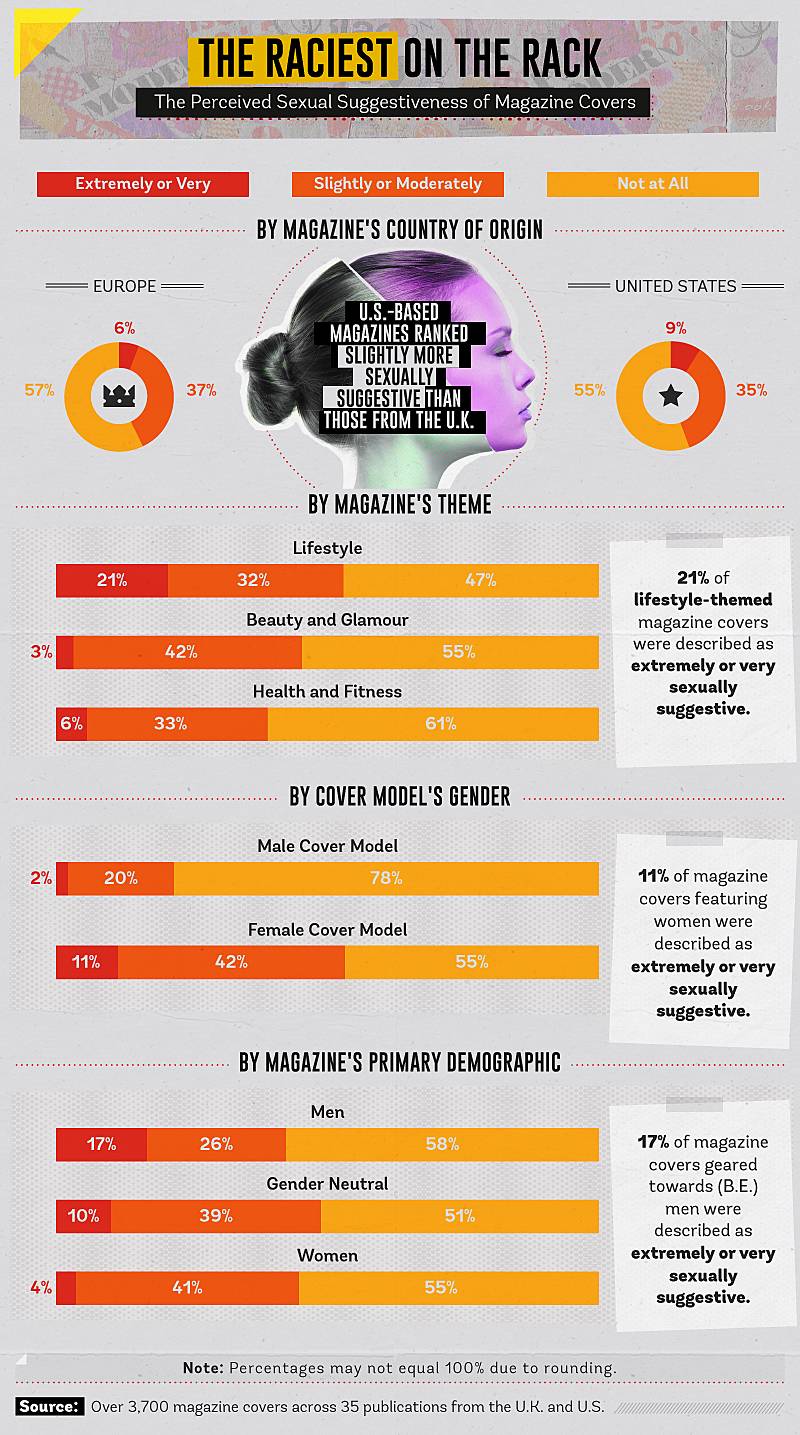
To understand how the many magazine covers we studied are perceived by the people potentially perusing them, we asked over 230 people to rate how provocative they found the content being sold on magazine racks across both continents. According to their responses, American magazine covers were more likely to be seen as sexually suggestive than their European counterparts.
Research suggests the beauty ideals established by Western cultures have been spreading around the world. Today, those standards have spread to countries like India and Japan with potentially dangerous effects. A recent epidemic of body dissatisfaction and the spread of eating disorders has affected men and women regardless of their diverse cultures.
Our analysis also revealed beauty and fashion magazines weren’t always the most guilty culprit for suggestive imagery. According to people who participated in our poll, more than 1 in 5 lifestyle magazine covers were rated as either extremely or very sexually suggestive compared to only 3 percent of beauty and glamour publications and 6 percent of health and fitness brands.
Magazines with women on their covers were generally five times as likely to be seen as especially suggestive, but men and women surveyed acknowledged it was magazines geared towards a male audience that had the raciest covers of all.
Dissecting Diversity
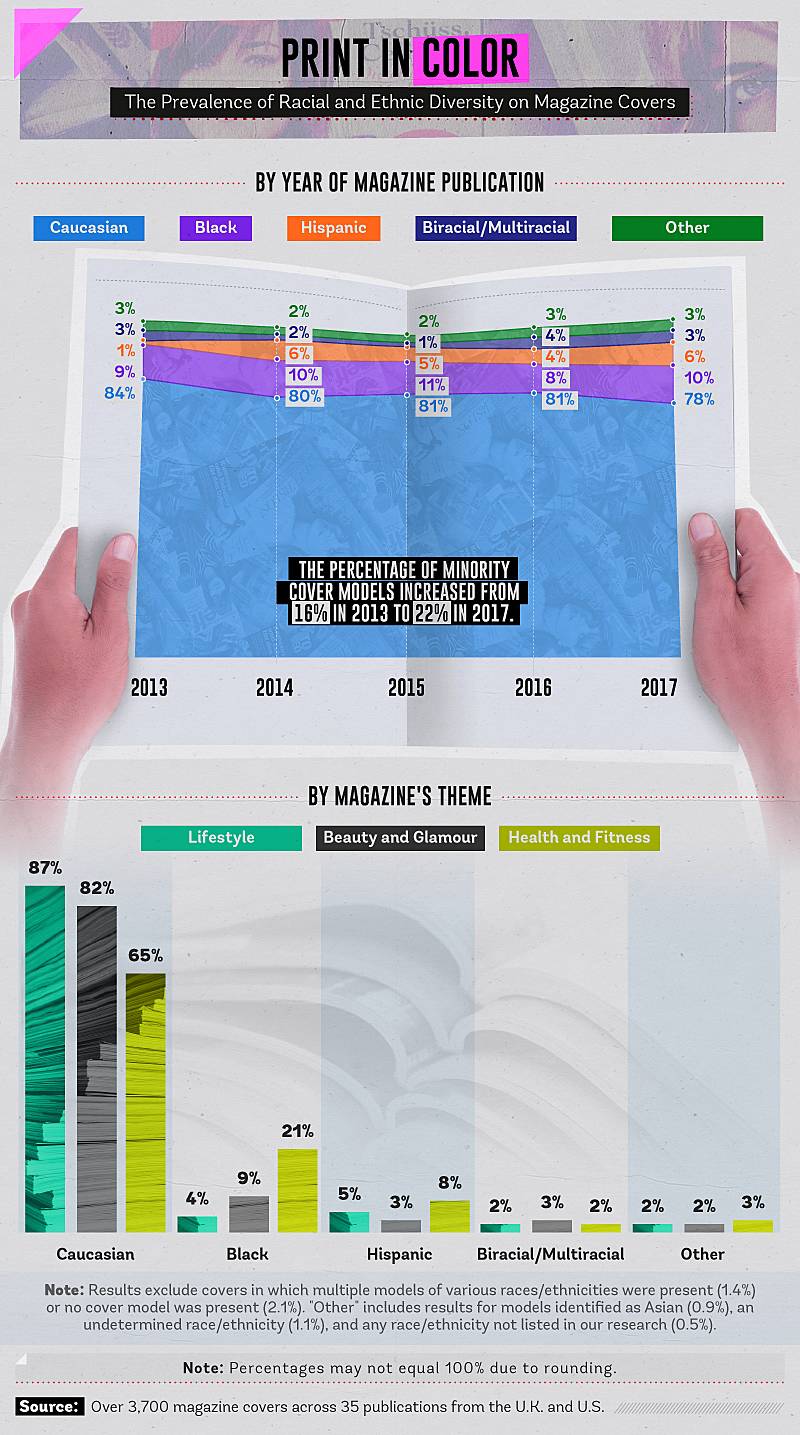
In 2013, 84 percent of magazine covers we studied have featured Caucasian models, actors, actresses, and pop culture icons. While that figure has fluctuated over the years, 2017 found 78 percent of magazine covers studied featured white cover models compared to only 10 percent black and 12 percent combined Hispanic, biracial, and any other ethnicity. While some numbers were unchanged since 2013, the percentage of hispanic models featured on the front of these magazines increased substantially over the four-year period and the over all minority presence rose from 16 percent to 22.
Even magazines that do include women of more diverse ethnicities on their covers have been accused of whitewashing their appearances to appeal to a broader market. In 2017, actress Lupita Nyong’o was featured on the cover of U.K. magazine Grazia, but publicly retaliated after her naturally textured hair was edited out of the cover image in favour of a “smoother” look. As others have identified, these inconsistencies create a body image stigma that women with a certain skin colour or hair type relating to ethnicity may be perceived as less beautiful than their Caucasian counterparts. In similar examples, adverts have used editing software to lighten the skin of darker models to make them appear more fair, reiterating a problematic standard that a lighter skin tone is more cosmetically appealing than dark skin.
Locks of Inspiration
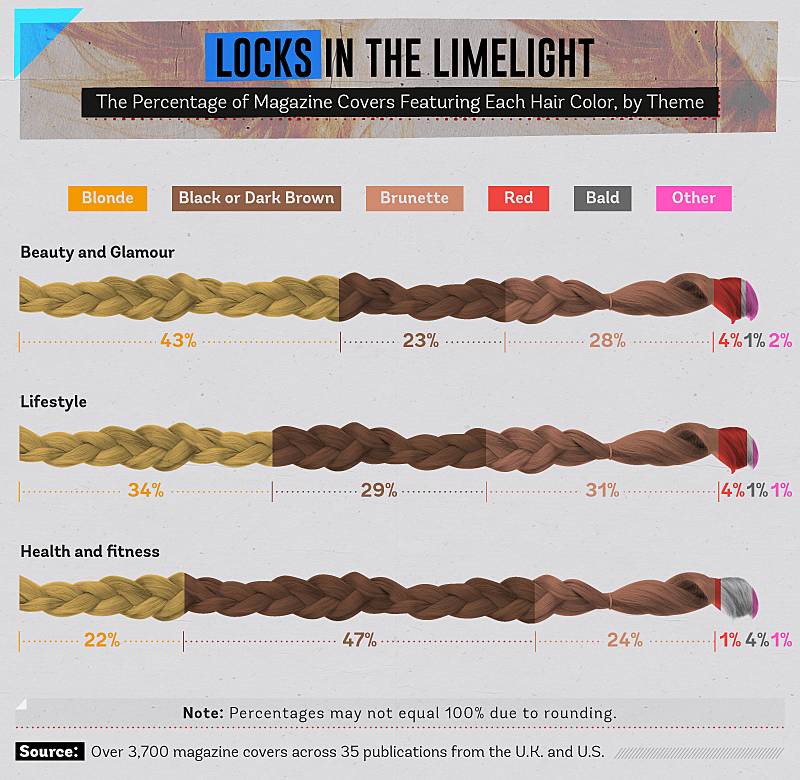
Celebrities have been influencing trends in hairstyles for decades, even amongst their peers.
Based on our analysis, we discovered certain hair colours might be more popular on the covers of certain magazines than others. Of the more than 3,700 unique covers across 35 different publications, more than 2 in 5 models featured on the front page of beauty and glamour magazines had blonde hair. Compared to 28 percent who were brunettes and only 23 percent with black or dark brown hair, blonde models had the highest representation on the covers of publications.
While blonde models dominated lifestyle magazines as well, brunettes were a close second and men and women with black or dark brown hair accounted for 47 percent of covers we studied from health and fitness publications.
At most, no more than 2 percent of cover models fell into our category of “other” for hair colours or styles, including natural grey. Women may feel especially pressured to dye their hair rather than let grey locks shine through, which can be a naturally occurring colour as early as the mid 30s for both men and women.
Subversive Headlines
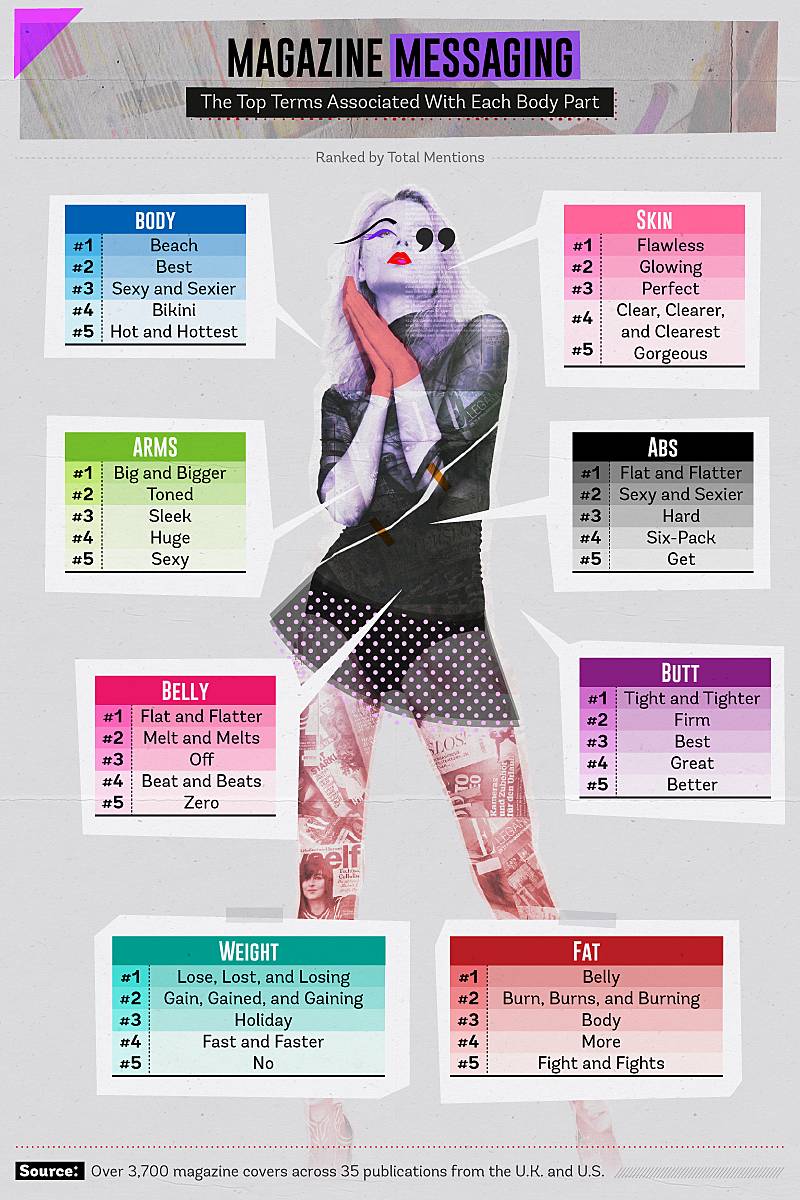
What comes to mind when you think of “flawless,” “flatter,” or “tight”? If you’re reading a magazine by some of the world’s most famous publishers, these words might spark thoughts about your body, including your skin, belly, and backside. Our study of magazine covers revealed the terms most commonly used to describe parts of both men’s and women’s physique according to cover headlines.
While the average woman’s body has changed significantly over the last several decades, you may be hard-pressed to find evidence of these shifts in major media adverts – including magazine publications. Analysts suggest these changes actually make women healthier today than they were in years past, but even the most impressionable audiences may be getting mixed signals from what they see in print portraying an ideal body type. Research suggests children as young as 5 years old may start to feel dissatisfaction with their bodies.
More Than Words
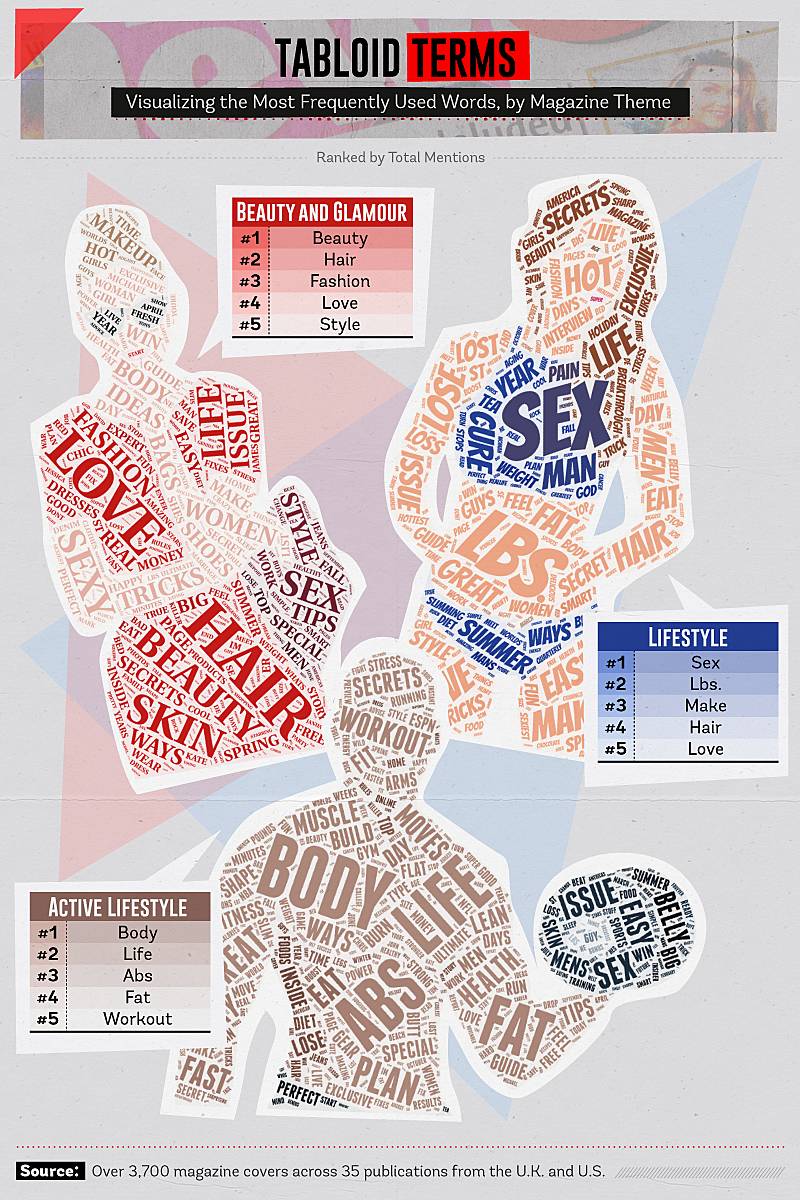
As we learned, beauty and fashion magazines might not have the raciest undertones in the way they project men and women on their covers – that label went to lifestyle magazines instead. So what kind of messaging are these magazines really portraying? To understand more, we analysed the most recurringwords on the covers of three magazine genres (health and fitness; fashion, beauty, and glamour; and general lifestyle) to determine what’s really considered “on brand” as far as their cover messaging is concerned.
Our research revealed the three most common themes were body, beauty, and sex for the three major genres of magazines available today. Increasing communication around sex and sexuality is one of the most important ways men and women become comfortable with their bodies and in their relationships. While approaching the subject may be admirable for these mainstream publications, combining them with unrealistic standards of beauty or hypersexualised images (as we discovered) may be counterintuitive to the point. In reality, research suggests these exaggerated images are doing more harm than good to the way audiences around the world feel about their bodies.
Breaking Down Barriers
Depending on how committed you are to a particular brand or magazine, the modern beauty standards they perpetuate in terms of body type, skin colour, or even hairstyle could be having a significant impact on how you feel about your own body. At least one study found looking at a magazine for just 60 minutes lowered the self-esteem of 80% of female participants. Worse yet, those influences are everywhere; not just in magazines, but on screens, in social media, and on the web. Despite being heavily manipulated, the reality is printed media projects have a profound impact on the men and women who view them.
Despite these obstacles, building healthy self-confidence means challenging the stigmas created by unrealistic and unattainable standards of beauty and sex. At ZAVA, we know real confidence is within reach and no one should feel embarrassed or confused by their most intimate needs. By providing the access you need for your sexual health concerns through our convenient online process, the treatment you need can be prescribed by registered U.K. doctors and delivered quickly and discreetly right to your doorstep. Never worry about getting an appointment just to get your prescription again. Visit us online now at ZAVA services to learn more.
Methodology
We scraped 3,775 magazine covers across 35 publications. The scrape was performed from 3 p.m. on Oct. 11, 2017 to 3 p.m. on Oct. 12, 2017. The most recent magazine publication date available was for November 2017. The range of available editions varied for each publication. We ran all the magazine covers through the Microsoft Computer Vision API to detect and extract the text from images.
Of publications scraped, 17 were U.S.-based, and 18 were U.K.-based. We selected the top U.S. publications by circulation, which primarily featured magazine cover models. Publication circulation and magazine topic areas were categorised according to echo-media.com, condenast.com, ellemediakit.com, menshealthmediakit.com, and seventeenmediakit.com. U.K. versions of U.S. publications were selected when available. The race or ethnicity, gender, hair colour, and sexual suggestiveness of each magazine cover was surveyed according to 235 Amazon Mechanical Turk workers at 11 a.m. on Nov. 14, 2017. Amazon Mechanical Turk is a platform for crowdsourcing human intelligence tasks.
The following publications were included in our research: Allure, Cosmopolitan, Cosmopolitan UK, Elle, Elle UK, ESPN the Magazine, Esquire, Glamour, Glamour UK, GQ, GQ UK, Harper’s Bazaar, Marie Claire, Marie Claire UK, Maxim, Men’s Health, Men’s Health UK, Men’s Journal, Men’s Fitness UK, Muscle & Fitness UK, Playboy, Red UK, Redbook, Seventeen, Shape, Slimming World, Teen Vogue, The Rake, Top Sante, Vanity Fair, Vogue UK, Woman’s World, Women’s Health, Women’s Health UK, and Women’s Running.
Limitations
The data related to race and ethnicity, gender, hair colour, and sexual suggestiveness of each magazine cover rely on self-reporting and are subjective to the individual respondent. This content is exploratory. For some magazine covers, the publication date was not able to be determined.
Fair Use Statement
Think your audience will appreciate our perspective on the advert trends identified in our study? We’d love to see the results of our study shared on your site or blog for any noncommercial use. Just make sure to link back to this page so your readers can see our study in its entirety.
Explore ZAVA services
| Service | Treatment | |
|---|---|---|
| Men's health | ||
| Women's Health | Microgynon, Cerelle pill, Cerazette, Yasmin pill, Lucette, Rigevidon, Cilique, Evra patch |
|
| General Health | ||
| Sexual Health | ||
Genital Chlamydia and Gonorrhoea Test, Oral Chlamydia and Gonorrhoea Test, Extended STI Test, Chlamydia Test, HIV Test, HPV Test |
||
| Chronic Health | ||
Atorvastatin, Simvastatin, Rosuvastatin, Cholesterol Test Kit |
||
| Travel Health | ||